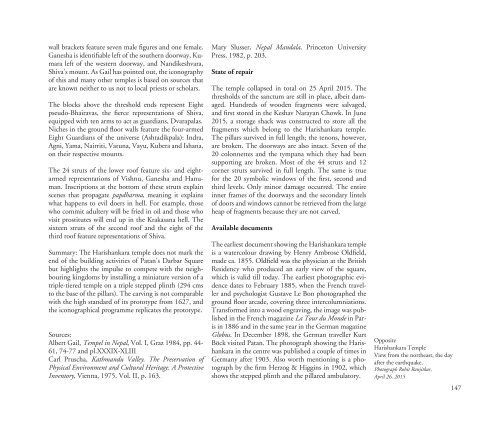KVPT’s Patan Darbar Earthquake Response Campaign - Work to Date - September 2016
Create successful ePaper yourself
Turn your PDF publications into a flip-book with our unique Google optimized e-Paper software.
wall brackets feature seven male figures and one female.<br />
Ganesha is identifiable left of the southern doorway, Kumara<br />
left of the western doorway, and Nandikeshvara,<br />
Shiva's mount. As Gail has pointed out, the iconography<br />
of this and many other temples is based on sources that<br />
are known neither <strong>to</strong> us not <strong>to</strong> local priests or scholars.<br />
The blocks above the threshold ends represent Eight<br />
pseudo-Bhairavas, the fierce representations of Shiva,<br />
equipped with ten arms <strong>to</strong> act as guardians, Dvarapalas.<br />
Niches in the ground floor walls feature the four-armed<br />
Eight Guardians of the universe (Ashtadikpala): Indra,<br />
Agni, Yama, Nairriti, Varuna, Vayu, Kubera and Ishana,<br />
on their respective mounts.<br />
The 24 struts of the lower roof feature six- and eightarmed<br />
representations of Vishnu, Ganesha and Hanuman.<br />
Inscriptions at the bot<strong>to</strong>m of these struts explain<br />
scenes that propagate papdharma, meaning it explains<br />
what happens <strong>to</strong> evil doers in hell. For example, those<br />
who commit adultery will be fried in oil and those who<br />
visit prostitutes will end up in the Krakasana hell. The<br />
sixteen struts of the second roof and the eight of the<br />
third roof feature representations of Shiva.<br />
Summary: The Harishankara temple does not mark the<br />
end of the building activities of <strong>Patan</strong>'s <strong>Darbar</strong> Square<br />
but highlights the impulse <strong>to</strong> compete with the neighbouring<br />
kingdoms by installing a miniature version of a<br />
triple-tiered temple on a triple stepped plinth (294 cms<br />
<strong>to</strong> the base of the pillars). The carving is not comparable<br />
with the high standard of its pro<strong>to</strong>type from 1627, and<br />
the iconographical programme replicates the pro<strong>to</strong>type.<br />
Sources:<br />
Albert Gail, Tempel in Nepal, Vol. I, Graz 1984, pp. 44-<br />
61, 74-77 and pl.XXXIX-XLIII<br />
Carl Pruscha, Kathmandu Valley. The Preservation of<br />
Physical Environment and Cultural Heritage. A Protective<br />
Inven<strong>to</strong>ry, Vienna, 1975. Vol. II, p. 163.<br />
Mary Slusser, Nepal Mandala, Prince<strong>to</strong>n University<br />
Press, 1982, p. 203.<br />
State of repair<br />
The temple collapsed in <strong>to</strong>tal on 25 April 2015. The<br />
thresholds of the sanctum are still in place, albeit damaged.<br />
Hundreds of wooden fragments were salvaged,<br />
and first s<strong>to</strong>red in the Keshav Narayan Chowk. In June<br />
2015, a s<strong>to</strong>rage shack was constructed <strong>to</strong> s<strong>to</strong>re all the<br />
fragments which belong <strong>to</strong> the Harishankara temple.<br />
The pillars survived in full length; the tenons, however,<br />
are broken. The doorways are also intact. Seven of the<br />
20 colonnettes and the tympana which they had been<br />
supporting are broken. Most of the 44 struts and 12<br />
corner struts survived in full length. The same is true<br />
for the 20 symbolic windows of the first, second and<br />
third levels. Only minor damage occurred. The entire<br />
inner frames of the doorways and the secondary lintels<br />
of doors and windows cannot be retrieved from the large<br />
heap of fragments because they are not carved.<br />
Available documents<br />
The earliest document showing the Harishankara temple<br />
is a watercolour drawing by Henry Ambrose Oldfield,<br />
made ca. 1855. Oldfield was the physician at the British<br />
Residency who produced an early view of the square,<br />
which is valid till <strong>to</strong>day. The earliest pho<strong>to</strong>graphic evidence<br />
dates <strong>to</strong> February 1885, when the French traveller<br />
and psychologist Gustave Le Bon pho<strong>to</strong>graphed the<br />
ground floor arcade, covering three intercolumniations.<br />
Transformed in<strong>to</strong> a wood engraving, the image was published<br />
in the French magazine La Tour du Monde in Paris<br />
in 1886 and in the same year in the German magazine<br />
Globus. In December 1898, the German traveller Kurt<br />
Böck visited <strong>Patan</strong>. The pho<strong>to</strong>graph showing the Harishankara<br />
in the centre was published a couple of times in<br />
Germany after 1903. Also worth mentioning is a pho<strong>to</strong>graph<br />
by the firm Herzog & Higgins in 1902, which<br />
shows the stepped plinth and the pillared ambula<strong>to</strong>ry.<br />
Opposite<br />
Harishankara Temple<br />
View from the northeast, the day<br />
after the earthquake.<br />
Pho<strong>to</strong>graph Rohit Ranjitkar,<br />
April 26, 2015<br />
147




